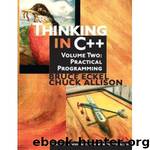Thinking In C++. Volume 2: Practical Programming by Bruce Eckel & Chuck Allison

Author:Bruce Eckel & Chuck Allison
Language: eng
Format: epub
Publisher: Prentice Hall
Published: 2003-12-08T16:00:00+00:00
The string v, which is a container of characters, as you know, is filled with randomly generated characters. Each character is used in a remove statement, but the entire string v is printed out each time so you can see what happens to the rest of the range, after the resulting endpoint (which is stored in cit).
To demonstrate remove_if( ), the address of the standard C library function isupper( ) (in <cctype> is called inside the function object class IsUpper, an object of which is passed as the predicate for remove_if( ). This returns true only if a character is uppercase, so only lowercase characters will remain. Here, the end of the range is used in the call to print( ) so only the remaining elements will appear. The copying versions of remove( ) and remove_if( ) are not shown because they are a simple variation on the noncopying versions, which you should be able to use without an example.
The range of lowercase letters is sorted in preparation for testing the "unique" functions. (The "unique" functions are not undefined if the range isn’t sorted, but it’s probably not what you want.).. First, unique_copy( ) puts the unique elements into a new vector using the default element comparison, and then the form of unique( ) that takes a predicate is used; the predicate used is the built-in function object equal_to( ), which produces the same results as the default element comparison.
Download
This site does not store any files on its server. We only index and link to content provided by other sites. Please contact the content providers to delete copyright contents if any and email us, we'll remove relevant links or contents immediately.
Hello! Python by Anthony Briggs(10196)
The Mikado Method by Ola Ellnestam Daniel Brolund(10106)
OCA Java SE 8 Programmer I Certification Guide by Mala Gupta(10043)
Algorithms of the Intelligent Web by Haralambos Marmanis;Dmitry Babenko(8587)
Sass and Compass in Action by Wynn Netherland Nathan Weizenbaum Chris Eppstein Brandon Mathis(7967)
Grails in Action by Glen Smith Peter Ledbrook(7940)
Test-Driven iOS Development with Swift 4 by Dominik Hauser(7898)
The Well-Grounded Java Developer by Benjamin J. Evans Martijn Verburg(7840)
Windows APT Warfare by Sheng-Hao Ma(7651)
Layered Design for Ruby on Rails Applications by Vladimir Dementyev(7383)
Blueprints Visual Scripting for Unreal Engine 5 - Third Edition by Marcos Romero & Brenden Sewell(7287)
Secrets of the JavaScript Ninja by John Resig Bear Bibeault(6736)
Kotlin in Action by Dmitry Jemerov(5367)
Solidity Programming Essentials by Ritesh Modi(4466)
Hands-On Full-Stack Web Development with GraphQL and React by Sebastian Grebe(4400)
WordPress Plugin Development Cookbook by Yannick Lefebvre(4275)
Unity 3D Game Development by Anthony Davis & Travis Baptiste & Russell Craig & Ryan Stunkel(4183)
Functional Programming in JavaScript by Mantyla Dan(4168)
The Ultimate iOS Interview Playbook by Avi Tsadok(4158)
